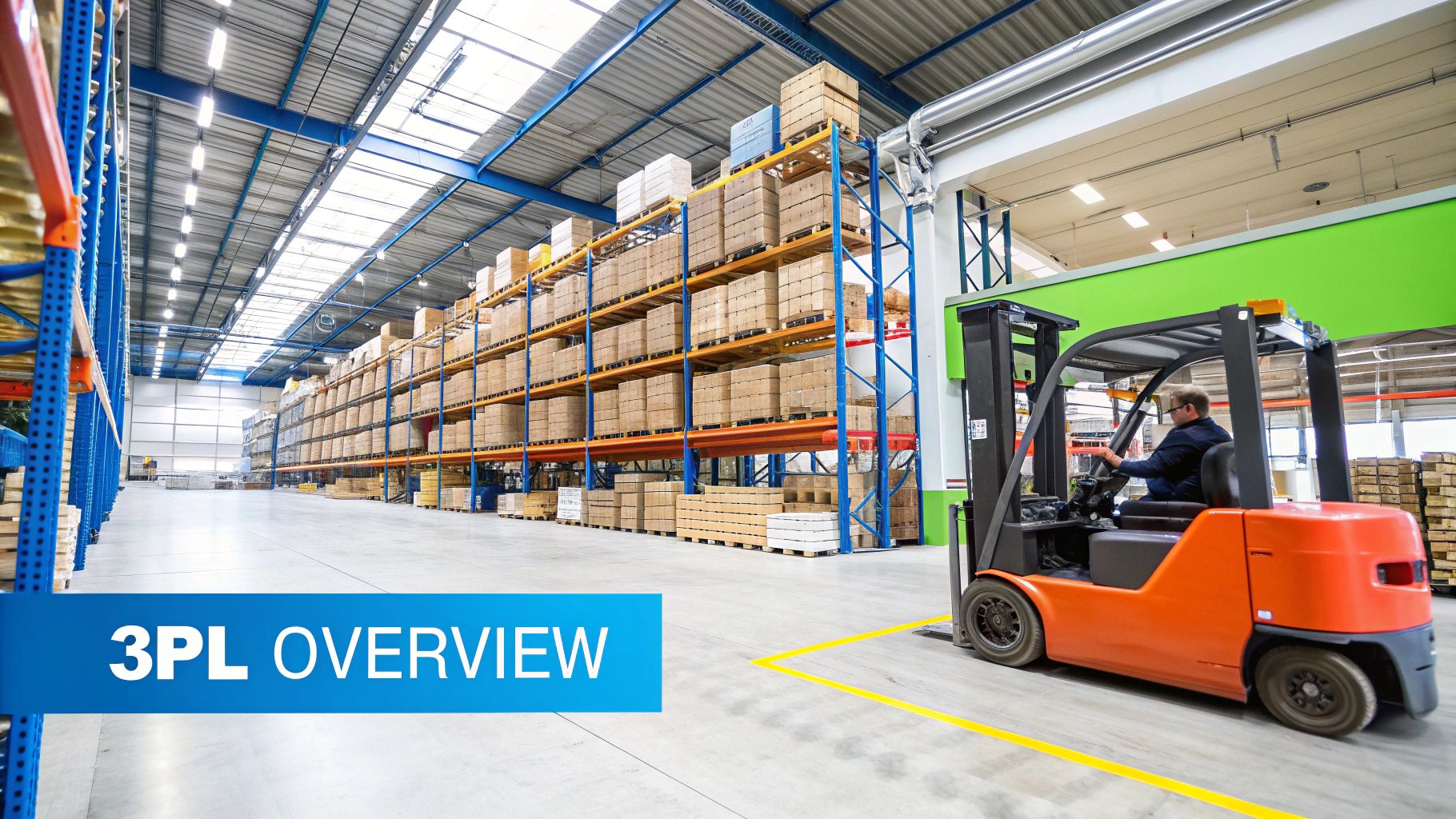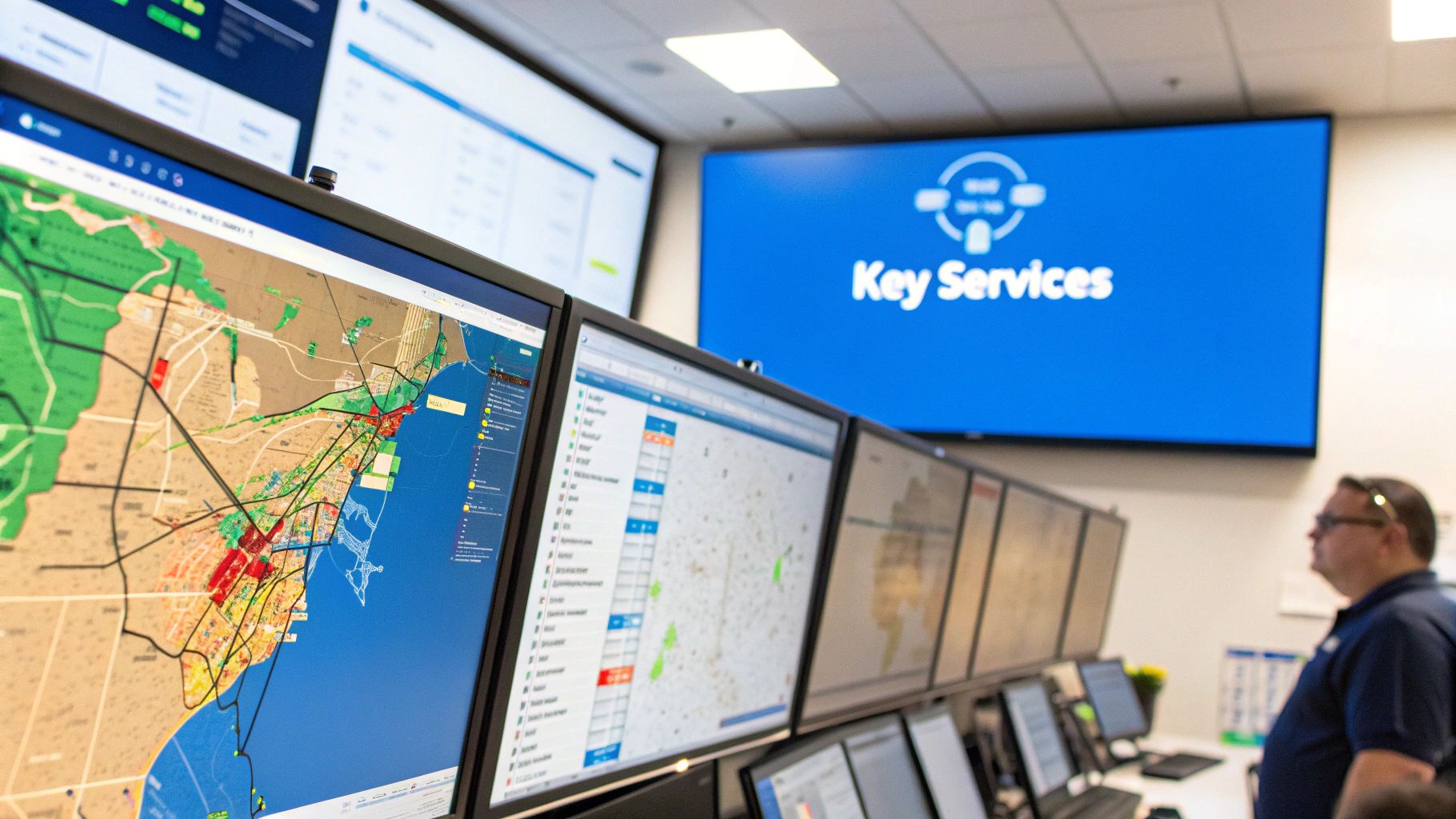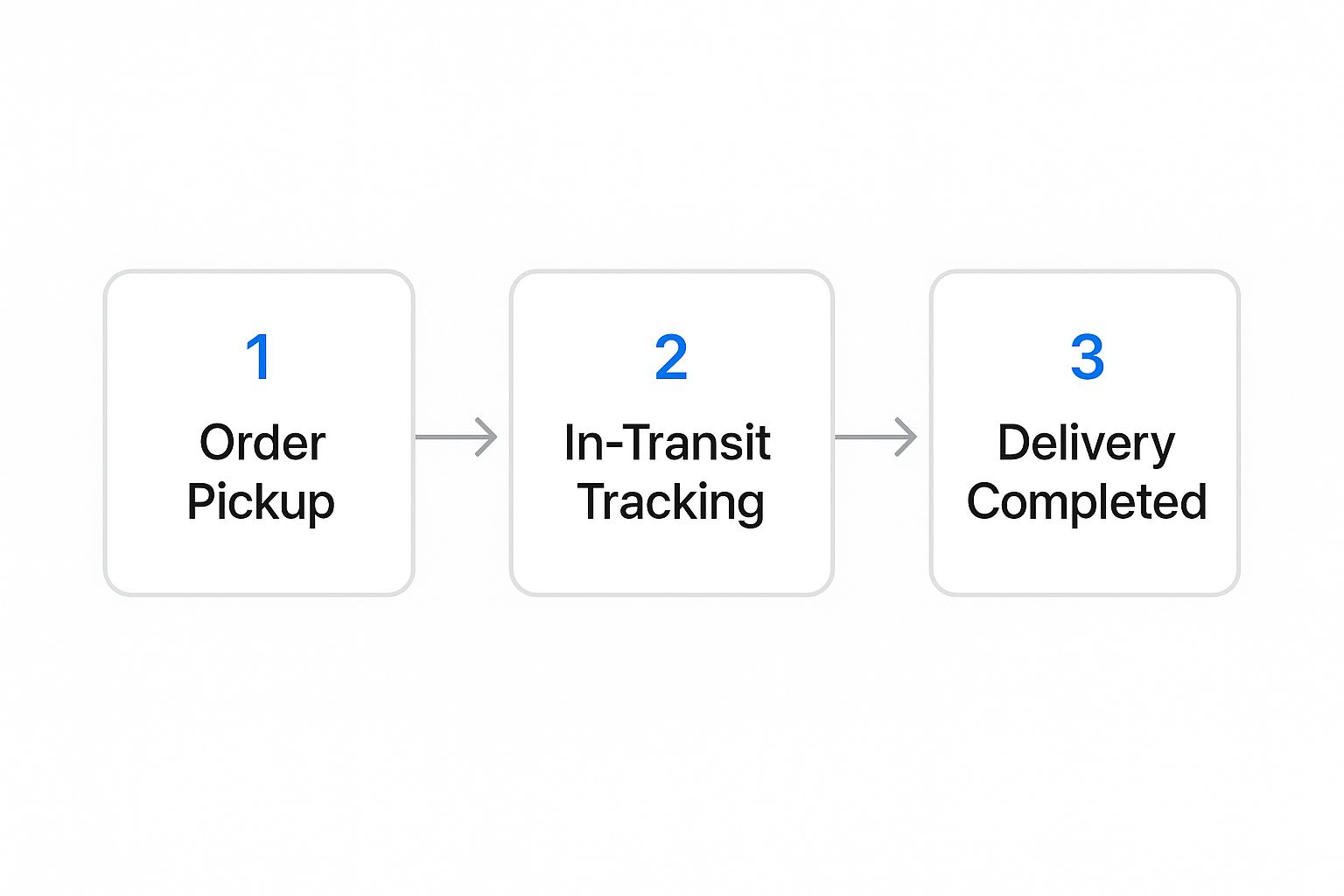So, what exactly does a 3PL do?
Think of it this way: a third-party logistics (3PL) provider is the partner who handles every physical step of your e-commerce business after a customer clicks ‘buy.’ They take care of the warehousing, inventory, and order fulfillment so you can stay focused on building your brand.

Let's use an analogy. Imagine your e-commerce brand is a hit new restaurant. You’re incredible at crafting the perfect menu (product development) and drawing in crowds of hungry diners (marketing). But the second a food order is placed, a whole different set of skills is needed—prepping ingredients, cooking, plating, and getting the right dish to the right table while it's still hot.
A 3PL is your expert, outsourced kitchen crew. While you’re out front perfecting the menu and filling the seats, they’re in the back flawlessly managing the entire operation.
They receive your bulk ingredients (your inventory), store them in their professional-grade kitchen (the fulfillment center), and when an order ticket comes in, they expertly pick, pack, and ship it out.
This partnership frees you from the massive operational headache of running a physical logistics machine. You don't have to sink capital into warehouse leases, hire an army of staff, or spend hours negotiating shipping rates. Instead, you plug into an efficient system that’s already built to scale.
If you want to go deeper on the fundamentals, we cover them in our complete guide to third-party logistics.
To really get what a 3PL does on a daily basis, it helps to break down their core services. Each one is designed to solve a specific, nagging problem that every growing e-commerce brand faces, turning logistical hurdles into managed processes. A great example of this in action is seeing how brands achieve efficient Amazon fulfillment with 3PL logistics.
The table below gives you a quick snapshot of these key services.
This table breaks down the main jobs a 3PL handles, what each one involves, and why it's a game-changer for your business.
At the end of the day, each of these functions works together to create a seamless experience for your customer, getting the right product into their hands quickly and reliably.

If you think a 3PL just sticks labels on boxes, it's time to look under the hood. A modern 3PL is a sophisticated, tech-powered operation that essentially becomes the physical backbone of your e-commerce brand. It replaces massive, capital-heavy tasks with a flexible, scalable partnership.
At its core, a 3PL handles three critical functions that form the engine of your business. The foundation is warehousing, but this goes way beyond just storing products on a shelf. When your inventory arrives, it’s methodically received, inspected for accuracy and damage, and then securely stored in an organized system. This isn't just about keeping things safe; it's about making sure your products are ready to go the moment an order hits.
From there, inventory management takes over as the brain of the operation. Modern 3PLs use advanced software to track every single item in real-time.
Imagine having the same level of inventory visibility as a major retailer. That’s exactly what a 3PL’s warehouse management system (WMS) provides. This technology plugs directly into your e-commerce store, giving you a live, accurate count of your stock levels for every product (or SKU).
This real-time data is an absolute game-changer for a few key reasons:
Finally, you have the most visible piece of the puzzle: order fulfillment. This is the classic "pick, pack, and ship" process, but it’s executed with incredible speed and precision.
When a customer clicks "buy," that order is instantly zapped to the 3PL's system. A warehouse team member is then directed to the exact bin location, picks the items, packs them securely, and gets the package ready for shipment. The entire workflow is fine-tuned for accuracy and efficiency.
The scope of what a 3PL can do is massive. In the United States alone, the 3PL industry hit a market size of $138.4 billion, with services spanning everything from domestic transportation to international shipping and warehousing.
Modern 3PLs also handle specialized services that can save you a ton of headaches. For example, many have the expertise to efficiently handle FBA inventory returns, streamlining a notoriously tricky process for Amazon sellers.
Of course, each of these services comes with specific costs. To get a clear breakdown of how it all works, check out our guide on demystifying 3PL pricing and fulfillment costs. By understanding these core functions, you can see how a 3PL transforms complex logistics into a simple, powerful partnership.
Understanding what a 3PL does is one thing. Connecting those services to actual, tangible business growth? That’s where the lightbulb really goes off. Bringing on a third-party logistics partner is a strategic move that can completely change your brand’s trajectory. It’s far less about just moving boxes and much more about unlocking your true potential to scale.
The global 3PL market is proof of this, with projections expecting it to blow past $1.4 trillion by 2030. This incredible expansion is almost entirely fueled by e-commerce—in fact, roughly 70% of all 3PL business now comes directly from online retail. That boom tells you everything you need to know about how essential these partnerships have become for brands trying to keep up with modern customer demands.
One of the first things you'll notice after partnering with a 3PL is a major drop in your operational costs. Instead of sinking huge amounts of capital into warehouse leases, employee salaries, and mountains of packing tape, you convert those massive fixed expenses into a single, predictable variable cost. You only pay for the space and services you actually use.
But the savings go deeper than that. 3PLs ship staggering volumes of packages every single day, which gives them access to heavily discounted shipping rates from major carriers like USPS, FedEx, and UPS. We're talking about rates an individual business could never hope to negotiate on its own, and those savings get passed directly to you and your customers.
Picture this: It's Black Friday. Your marketing campaign was a runaway success, and orders are flooding in at ten times your normal rate. If you're handling your own fulfillment, this is a moment of pure panic—a frantic scramble to pack orders, avoid mistakes, and stop shipping delays from piling up.
For a brand partnered with a 3PL, it’s just another Tuesday.
A 3PL is built for fluctuation. Their infrastructure, staff, and technology are designed to handle massive order spikes without breaking a sweat. This elasticity means you can scale your sales volume up or down instantly without ever worrying if your operations can keep up.
This ability to scale on a dime is a powerful growth engine. It frees you up to launch aggressive marketing campaigns and expand into new markets with total confidence, knowing your fulfillment machine is ready for whatever you throw at it. We explore this in more detail in our guide to optimal 3PL fulfillment strategies for e-commerce.
In today’s market, the customer experience is king. Fast, reliable, and accurate shipping isn't a bonus anymore; it’s the bare minimum expectation. A 3PL partnership can turn this crucial touchpoint from a potential liability into one of your biggest strengths.
By spreading your inventory across a network of fulfillment centers, a 3PL can offer things like nationwide 2-day shipping without the insane price tag. That kind of speed and reliability builds incredible brand loyalty. On top of that, their professional packing processes slash order errors, making sure customers get exactly what they ordered, every single time. A 3PL also gives you the tech tools for more precise shipping controls, like helping with setting up WooCommerce shipping restrictions by zip code to fine-tune your delivery zones.
Ever wondered what really happens between a customer’s click and that satisfying knock on their door? The journey an order takes through a 3PL is a finely tuned dance of technology and human expertise. Let's pull back the curtain on how this complex operation feels so seamless.
The process actually kicks off long before a customer even thinks about buying. It starts the moment your inventory lands at the 3PL's fulfillment center. Here, your products are carefully received, checked for accuracy, and given a specific home in the warehouse—a process called inbounding.
The real magic is powered by seamless software integration. Your e-commerce store, whether it’s on Shopify, BigCommerce, or another platform, is connected directly to the 3PL’s warehouse management system (WMS). Think of this as a digital handshake that makes instant communication possible.
When a customer places an order on your site, that info is automatically fired off to the 3PL. No manual data entry, no delays. This signal immediately triggers a picking list for the warehouse team.
A fulfillment specialist gets this list on a handheld device, which maps out the most efficient route through the warehouse aisles to grab each item. This system is all about speed and, more importantly, accuracy—getting the right products to the right customer, every single time.
A 3PL’s ability to automate order transmission and picking is what makes same-day fulfillment possible. By eliminating manual steps, the time from customer purchase to package preparation is reduced from hours or days to mere minutes.
Once all the items are picked, they head over to a packing station. Here, another team member securely packs the order, chooses the right-sized box to keep shipping costs down, and adds any custom touches you require, like branded tissue paper or a promotional insert.
Next, the system generates a shipping label, automatically selecting the best carrier and service based on pre-set rules that balance cost and delivery speed. The package is then handed off to FedEx, USPS, or another carrier to begin the final leg of its journey.
This visual breaks down the key stages of this shipping journey from the warehouse to your customer's doorstep.

This flow highlights how each step is a crucial link in the chain, ensuring a package is picked correctly, tracked effectively, and delivered successfully.
At the same time, the tracking information is sent right back to your e-commerce platform. This simple action triggers the shipping confirmation email to your customer, giving them the tracking number they need to watch their package’s progress. It’s a closed-loop system that provides total transparency for both you and your customer, from start to finish.

Picking a third-party logistics (3PL) partner is one of the most critical decisions an e-commerce brand will ever make. This isn't just about hiring a company to ship boxes. You're handing over your inventory, your order fulfillment, and a massive part of your customer experience to an outside team.
The right partner becomes a seamless extension of your brand, quietly and efficiently getting orders out the door. The wrong one? It can trigger operational nightmares, from lost inventory to angry customers waiting on late packages. Making an informed choice means looking past a simple price sheet to find a true partner.
To find the right fit, you need to dig into how a potential 3PL aligns with your specific business goals, product type, and technology stack. A mismatch in any of these areas can create friction and expensive problems down the road.
Start by focusing on three non-negotiable pillars:
For a more detailed breakdown, you can check out our complete guide on https://www.simplfulfillment.com/blog/how-to-choose-a-3pl-for-your-business.
The logistics world is massive and incredibly diverse, which makes doing your homework even more important. In the U.S. alone, there are roughly 72,937 3PL businesses. That number covers everything from global giants with their own fleets of planes to nimble, tech-first firms built for DTC brands.
This variety means there is a perfect fit out there for your business, but you have to know what you’re looking for. You can discover more insights about the global 3PL market on Precedence Research.
To help you compare your options apples-to-apples, we've put together a framework for evaluating potential partners. Think of this as your checklist for making a smart, strategic decision.
This table isn't just about ticking boxes; it’s about finding a partner whose capabilities truly align with your long-term vision.
Choosing a 3PL isn’t about finding the cheapest option. It’s about finding the best value—a partner whose capabilities, network, and expertise will actively support and accelerate your growth for years to come.
The final piece of the puzzle is understanding their pricing. Ask for a crystal-clear breakdown of costs for receiving, storage, pick-and-pack services, and shipping. A trustworthy partner will be completely transparent. By carefully weighing all these factors, you can find a 3PL that acts as a true strategic asset, helping you scale efficiently and delight your customers with every single order.
Deciding to bring on a third-party logistics provider is a huge step for any brand. It’s totally natural to have a bunch of questions about how it all works in the real world. Getting these common concerns cleared up can give you the confidence to know if a 3PL is the right move for your business.
Let's dive into some of the most frequent questions we hear from founders about costs, timing, and a few key industry terms.
There’s no single flat rate for 3PL services. Instead, the pricing is a combination of a few core fees. Think of it less like a massive upfront investment and more like paying for individual services as you use them. Typically, you'll see charges for:
While this might look like a lot of line items, remember what these costs are replacing: massive expenses like warehouse rent, employee salaries, and mountains of packing supplies. Most importantly, a good 3PL gives you access to heavily discounted shipping rates that can seriously offset, or even outweigh, these fees.
There isn’t a magic number, but a huge sign you’re ready is when fulfillment starts stealing time away from activities that actually grow your business. If you’re spending more of your day taping boxes than you are on marketing or product development, it’s time to start looking. For many brands, this tipping point happens somewhere around 100+ orders per month.
Other clear signs you're there include:
The real question to ask yourself is: "What is my time worth?" If your energy is better spent building your brand and connecting with customers, outsourcing the logistics is one of the smartest strategic moves you can make.
This is a really common point of confusion, but the distinction is pretty simple once you think about their specific jobs.
A freight forwarder is like a travel agent, but for a single, large shipment. Their whole job is to arrange transportation to get your bulk inventory from Point A (like your factory) to Point B (like a 3PL’s warehouse). It's usually a one-and-done transaction.
A 3PL, on the other hand, is your ongoing operational partner. They take over after your inventory has arrived. They store your products, connect to your online store, and handle the daily grind of picking, packing, and shipping individual orders straight to your customers. One moves the freight; the other fulfills the orders.
At Simpl Fulfillment, we provide transparent pricing and scalable solutions designed to grow with your brand. Our seamless integrations and dedicated support team handle the logistics, so you can focus on what you do best. Discover how we can fuel your growth.